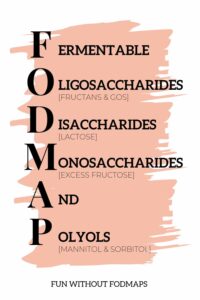FODMAP stands for Fermentable Oligosaccharides Disaccharides Monosaccharides And Polyols . These saccharides and polyols are short-chain carbohydrates that if poorly digested, ferment in the lower par of your large intestine. This fermentation process draws in water and produces carbon dioxide, hydrogen, and/or methane gas that cause the intestine to stretch and expand. The result is strong pain, bloating, visible abdominal distension. What exactly are these foods that contain these carbohydrates? I will attempt to break this down throughout the blog.
Over the years, I have come across many folks that struggle with abdominal pain, gastrointestinal issues, bloating, gas to name a few. They have tried improving their diet and do not necessarily find relief. This is when FODMAP was brought to my attention. FODMAP foods are generally “healthy items”, but certain individuals struggle to digest these FODMAPS properly, leading to many of the symptoms mentioned above. Following a low FODMAP protocol is essential for providing relief to some clients. The good news about following this protocol is that it is temporary. Once you have taken the time to eliminate high FODMAP foods, you may then slowly introduce one food item at a time and see if that food gives you symptoms. We eliminate high FODMAP foods so we can stabilize our gut, allow it to heal, then slowly introduce possible problematic foods and see if symptoms arise.

To ease IBS and SIBO symptoms, it’s essential to avoid high FODMAP foods that aggravate the gut, including:
- Dairy-based milk, yogurt and ice cream
- Wheat-based products such as cereal, bread and crackers
- Beans and lentils
- Some nuts, such as cashews, pistachios
- Some vegetables, such as artichokes, asparagus, onions and garlic
- Some fruits, such as apples, cherries, pears and peaches
Instead, base your meals around low FODMAP foods such as:
- Eggs and meat
- Certain cheeses such as brie, Camembert, cheddar and feta
- Almond milk, Coconut milk
- Grains like rice, quinoa and oats
- Vegetables like eggplant, potatoes, tomatoes, cucumbers and zucchini
- Fruits such as kiwis, oranges, strawberries, blueberries and pineapple
Follow a low FODMAP protocol which is a three-step elimination diet as cited by John Hopkins Medicine, see below:
- First, you stop eating certain foods (high FODMAP foods).
- Next, you slowly reintroduce them to see which ones are troublesome.
- Once you identify the foods that cause symptoms, you can avoid or limit them while enjoying everything else worry-free.
“We recommend following the elimination portion of the diet for only two to six weeks,” says Veloso. “This reduces your symptoms and if you have SIBO, it can help decrease abnormally high levels of intestinal bacteria. Then every three days, you can add a high FODMAP food back into your diet, one at a time, to see if it causes any symptoms. If a particular high FODMAP food causes symptoms, then avoid this long term.”
Throughout my research on FODMAP, I came across a university in Australia, Monash University. In 2005, researchers in the Department of Gastroenterology at Monash University identified a group of short-chain carbohydrates found in food that are either poorly absorbed in the small intestine or impossible to digest. The Monash team named these carbohydrates FODMAP. The university was the first to identify and research these foods in this nature. Thanks to Monash University’s extensive work in this area, people can take their gut health back into their own hands by managing their symptoms through diet and improve their overall quality of life.

As you do your own research on FODMAP, you will discover there is no black and white with food choices. The best way to discover which foods work and do not work for you, is the elimination diet, then journal your symptoms or lack their of when you reintroduce the eliminated foods. Best of luck on your health journey! I am always here to support and coach you, reach out for a FREE discovery call if you would like to explore my services further!

